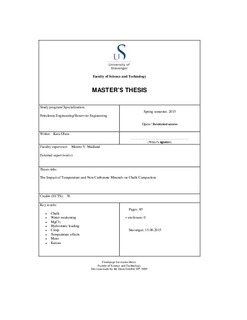| dc.contributor.author | Olsen, Kaia | |
| dc.date.accessioned | 2015-09-21T13:15:12Z | |
| dc.date.available | 2015-09-21T13:15:12Z | |
| dc.date.issued | 2015-06-15 | |
| dc.identifier.uri | http://hdl.handle.net/11250/300949 | |
| dc.description | Master's thesis in Petroleum engineering | nb_NO |
| dc.description.abstract | There has been a considerable research activity concerning the effect of brine chemistry on the mechanical behaviour of chalk since the discovery of the Ekofisk subsidence in the North Sea. Although the research on water weakening on chalk are extensive, the mechanism behind the weakening is still not fully understood. The objective of this thesis was to investigate how chalk mechanics are affected by different temperatures and chalk types during flooding of MgCl2 brine. Mechanical tests were performed on 130, 92 and 60C for two different outcrop chalk types; Mons (Belgium) and Kansas (Niobrara, US). The cores were loaded hydrostatically above yield up to a confining pressure of 14 MPa (Mons) or 24 MPa (Kansas) with a pore pressure of 0.7 MPa, followed by a 60 days creep phase of constant stress and temperature. Fractioned effluent were analysed by an ion chromatograph and microscopic studies of the tested core by SEM-EDS were performed.
During hydrostatic loading no significant difference in yield strength and in the bulk modulus was observed for Kansas chalk when comparing the test at different temperatures. While for the Mons chalk a difference between the core tested at 130C was seen compared to the cores tested at lower temperatures (60 and 92C). At 130C Mons compacts less than at lower temperatures. During creep phase, on the other hand, temperature dependency on chalk compaction was observed for both Mons and Kansas chalk. Accelerating creep was observed for the core testes at 130C causing a significant higher creep strain compared to the cores tested at lower temperatures. From ion chromatograph analysis, the dissolution-precipitation process between magnesium and calcium was seen to more or less have a one-to-one relationship. Magnesium precipitation and calcium dissolution increased with increasing temperature, which resulted in a higher core mass loss and more compaction as magnesium has a lower molar weight than calcium. These results were confirmed by higher core mass loss for higher temperatures. SEM-EDS analysis also confirmed these results when three cores, one for each testing temperature, were studied. The wt% of magnesium in the core was seen to increase with increasing testing temperature. Precipitation of magnesite was detected by the inlet side of the Mons core tested at 130C.
Analysis of effluent pH indicated that for cores tested at 130C the pH is more or less the same as injected brine pH (5.5-6.0), while for cores tested at lower temperatures (60 and 92C) the pH seemed to be higher (6.1-6.5) compared to injected brine pH. | nb_NO |
| dc.language.iso | eng | nb_NO |
| dc.publisher | University of Stavanger, Norway | nb_NO |
| dc.relation.ispartofseries | Masteroppgave/UIS-TN-IPT/2015; | |
| dc.rights | Navngivelse 3.0 Norge | * |
| dc.rights.uri | http://creativecommons.org/licenses/by/3.0/no/ | * |
| dc.subject | petroleumsteknologi | nb_NO |
| dc.subject | petroleum engineering | nb_NO |
| dc.subject | chalk | nb_NO |
| dc.subject | MgCl2 | nb_NO |
| dc.subject | water weakening | nb_NO |
| dc.subject | hydrostatic loading | nb_NO |
| dc.subject | creep | nb_NO |
| dc.subject | temperature effects | nb_NO |
| dc.subject | Mons | nb_NO |
| dc.subject | Kansas | nb_NO |
| dc.subject | reservoir engineering | nb_NO |
| dc.title | The impact of temperature and non-carbonate minerals on chalk compaction | nb_NO |
| dc.type | Master thesis | nb_NO |
| dc.subject.nsi | VDP::Technology: 500::Rock and petroleum disciplines: 510::Petroleum engineering: 512 | nb_NO |

